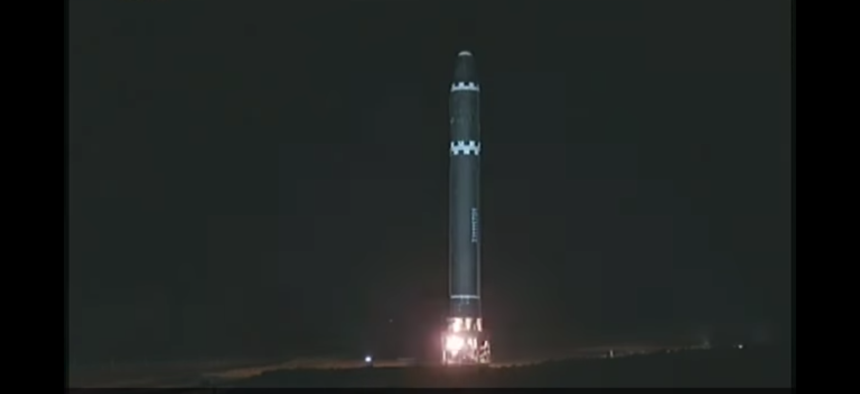
screengrab via KNCA
North Korea’s New Missile Is a Game-Changer
Photos show a nose cone big enough to carry multiple warheads, plus countermeasures that U.S. missile defenses have never been tested against.
The Hwasong-15 ICBM tested by North Korea on Nov. 28 is a monster. Many compare it to the Titan II, deployed by the United States to carry our largest, multi-megaton hydrogen bombs to targets halfway around the globe. Missile expert Mike Elleman at the International Institute for Strategic Studies calls it “a significant improvement in North Korea’s ability to target the US.” Even applying conservative assumptions about the missile’s engines, “it now appears that the Hwasong-15 can deliver a 1,000-kg payload to any point on the US mainland,” he writes at 38 North. “North Korea has almost certainly developed a nuclear warhead that weighs less than 700 kg, if not one considerably lighter.”
The test was conducted at night, using a mobile missile launcher, “simulating the operation conditions North Korea would actually use in a wartime scenario,” notes Harvard scholar Mira Rapp-Hopper in Defense One. “In short, North Korea’s missiles are increasingly sophisticated, increasingly survivable, and functionally capable of putting the entire U.S. homeland at risk,” she concludes. But “from a strategic perspective, this latest test is not a game-changer.”
That might be true if you are just looking at its longer range and more powerful engines. The first North Korea ICBM test, on July 4, flew the equivalent of over 4,000 miles and put Hawaii and Alaska within range. The second, on July 28, could fly more than 6,000 miles, bringing the West Coast and Midwest within range. This latest test demonstrated the ability to fly more than 8,000 miles. Washington is less than 7,000 miles from Pyongyang. (Mar-a-Lago is about 7,500 miles away.) By these numbers, the Hwasong-15 represents an increased threat, but more symbolic and psychological than strategic.
It’s the front end of the missile that changes everything. These video and photos, released after Rapp-Hopper published, show North Korean leader Kim Jung-un standing next to the huge, new transporter-erecter vehicle that is carrying the missile, prominently featuring its large, blunt nose cone. Even a casual observer can see that the missile could carry many Kim-sized objects within the nose cone. Nuclear warheads are typically the size of an average person or smaller. The hydrogen bomb “peanut-design” displayed by North Korea before their last nuclear test is at least that small.
This may mean that North Korea now has the capability to launch a missile carrying multiple warheads. This is not new technology. We had missiles with multiple warheads in the early 1960s. The Polaris A-3 submarine-launched ballistic missile carried three 200-kiloton bombs in what was first known as a “cluster warhead” design. The British used the Polaris in a similar configuration. The name was later changed to Multiple Re-Entry Vehicle or MRV. The Soviets soon deployed their own MRVs before nations moved to more sophisticated multiple independently-targetable re-entry vehicles, or MIRVs.
The warhead used by the Polaris, the W-58, was only 15.6 inches in diameter and 40 inches long, and weighed 117 kilograms. Of course, by the time this warhead was deployed in 1964 the United States had conducted 295 nuclear tests, including 105 above-ground nuclear tests in the Pacific Proving Grounds in the Marshall Islands. With only six nuclear tests so far, we don’t know if the North Koreans could produce a warhead this powerful and this small.
But they don’t have to. With their current design, they may be able to fit three warheads into the nose of the Hwasong-15. That would overwhelm the U.S. defense system. Current operational plans are to fire four to five interceptors at each incoming warhead. With 44 interceptors deployed, Middlebury Institute analyst Jeffrey Lewis has joked that we better hope North Korea has only 11 missiles, because the 12th would definitely get through.
With three warheads per missile, North Korea would only need four missiles to overwhelm the system. If the U.S. doubled the interceptors — adding considerably to the already $40 billion spent on the site — it would be far cheaper, easier and quicker for the North Koreans to double their missiles. By adding even simple decoys and other countermeasures, the North Koreans could have high confidence that they could blind, spoof, confuse, and otherwise overwhelm the U.S. defenses.
In short, it is a contest that missile defense cannot win.
But, wait. Why does it take so many interceptors? The plan to fire four or five interceptors at each target seems to be based on the test record to date, which has recorded hits in about half of its 18 tests. The math is simple: if one interceptor has a 50 percent chance of hitting, then two interceptors would increase that probability by half to 75 percent. Three would increase to 87.5 percent; four to 93.75 percent; five, to 96.875 percent. (This is the basis for Donald Trump’s mistaken claim to Sean Hannity that “We have missiles that can knock out a missile in the air 97 percent of the time, and if you can send two of them, it’s going to get knocked down.”)
Trump’s claim that one interceptor has a near-perfect chance of hitting the warhead is false, but so is the belief that five interceptors can protect us. “This reasoning is flawed,” argues James M. Acton, at the Carnegie Endowment for International Peace. “It assumes that the failure modes of the interceptors are independent of one another. But, in practice, if one interceptor fails because of a design flaw, say, it’s much more likely that others will do so, too, for the same reason.”
» Subscribed to The D Brief? Get the latest top national security and global military news delivered to your inbox every morning. Sign up here.
We now have a real-world example of this problem. The Saudis recently fired five U.S.-made Patriot interceptors at a short-range missile heading for the Riyadh airport. They claim to have intercepted the Yemeni missile, but there is no evidence to support that claim. New, independent analysis concludes that it is likely that all five failed, thanks to design limitations in the Patriot system and the complexities of the target.
The gigantic Hwasong-15 nose cone has room for decoys, chaff, jammers and other countermeasures alongside its warheads. Recall that the smaller Polaris carried penetration aids even though Moscow had yet to deploy any anti-missile systems. Can North Korea build countermeasures? Almost certainly. A 1999 intelligence estimate noted that any country capable of testing a long-range ballistic missile would “rely initially on readily available technology — including separating RVs [reentry vehicles], spin-stabilized RVs, RV reorientation, radar absorbing material, booster fragmentation, low-power jammers, chaff, and simple (balloon) decoys — to develop penetration aids and countermeasures.”
How will our defensive systems function against this threat? We have no basis for confidence. Our missile defenses have never undergone stringent, realistic tests. For example, we have only once tested the GMD system at night. And it missed. We have never tested it against realistic countermeasures.
Compare this to how U.S. businesses develop their high-tech products. General Motors is now testing on the streets of San Francisco and Denver a fleet of autonomous-driving vehicles it hopes to introduce in a few years. “Instead of testing their vehicles on a closed course or a ‘simple suburban setting,’” The Washington Post reports, “the company has opted to test the vehicles in an environment that resembles where they’ll be deployed.”
If only we tested our missile defenses as well as General Motors tests its cars.
